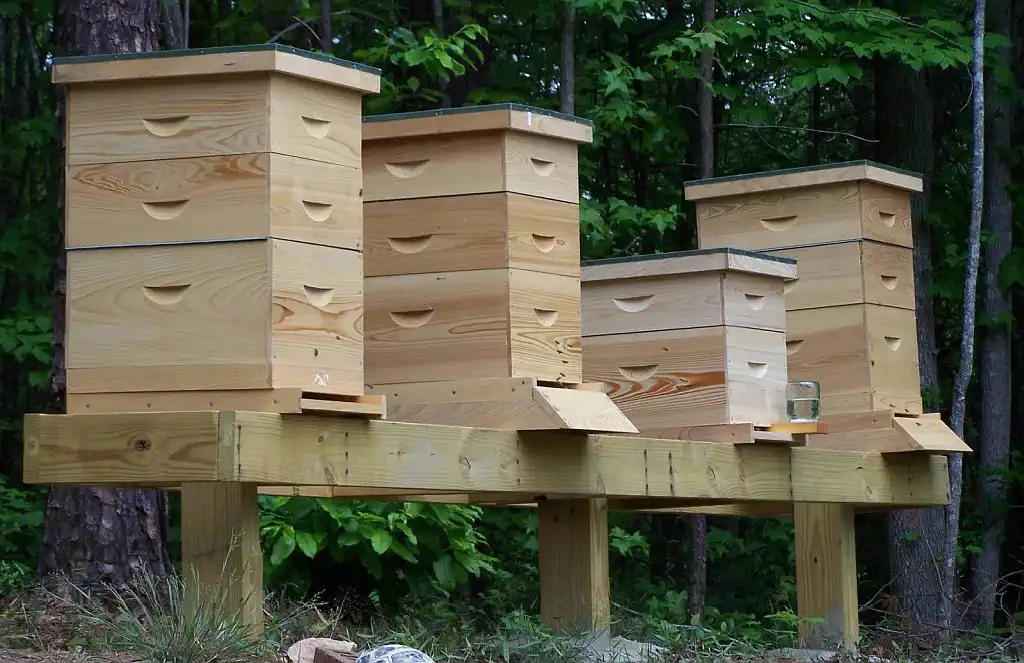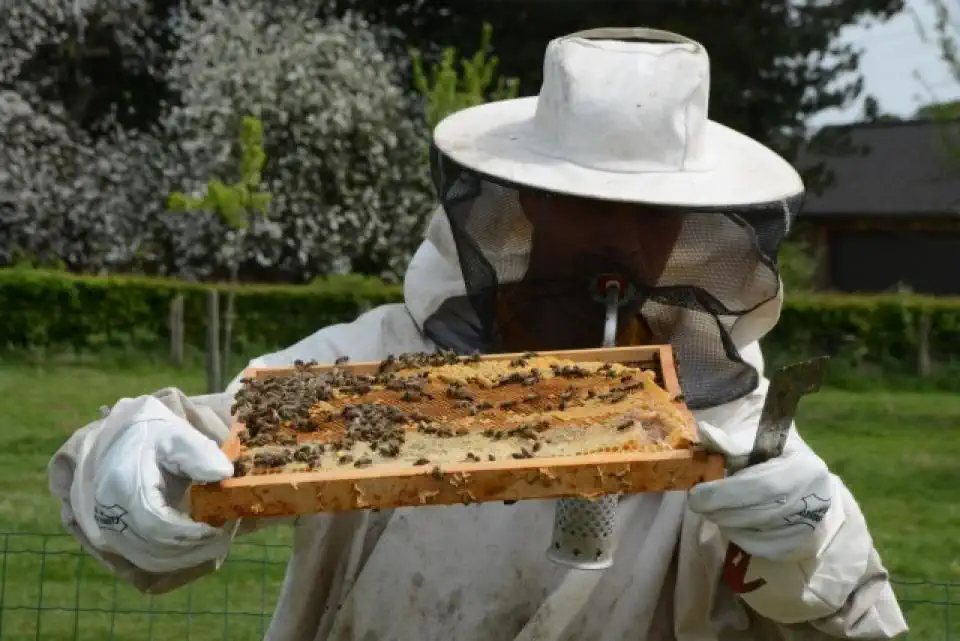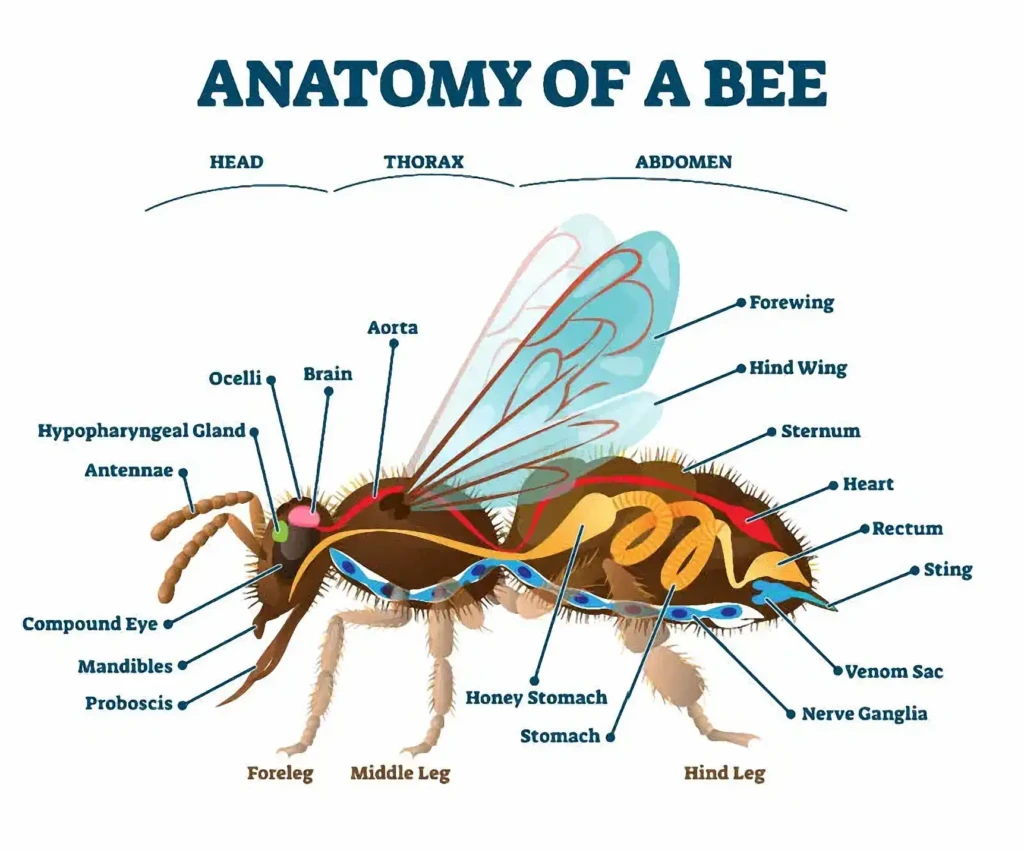More information about bees
Previous pages on bees have covered the following topics::
This page contains information on other bee issues.
- The life cycle of bees
- Keeping bees
- The anatomy of a bee
- Did you know? about bees
- Videos about bees
- Websites about bees
The life cycle of bees

Bees have a complex life cycle that is closely linked to their social structure and environment.
How long does a bee live?
The average age of a bee depends on the type of bee and when they pupated.
Queen: summer 3-4 years | winter 3-4 years
Dar: 22 days | winter 59 days
Worker bee: summer 36 days | winter 6 months
Egg and larva stage
The life cycle of a bee begins when the queen lays an egg. These eggs are laid in the cells of the honeycomb and within a few days the larvae hatch from the eggs. The larvae are fed by the worker bees, by a secretion from the glands of these bees. During this phase, the larvae undergo several moults as they grow.
An egg can become a worker or female but also a queen. The workers and queens are born from fertilised eggs, while the drone comes from an unfertilised egg. The DNA of drones is therefore identical to their mother, the queen, workers also have the DNA of their father. The queen carries DNA from several drones.
Pupation stage
After a few days, the larvae turn into pupae, enveloping themselves in a waxy cocoon. During this period, they undergo metamorphosis, developing into adult bees. The duration of this stage varies depending on the type of bee (worker, drone or queen).
Until the pupal stage, all bees are equal. They spend 3 days in an egg, then spend six days as a larva. From the pupal stage onwards, the development of workers, drones and queen diverges. The queen spends only 7 days in the pupal stage, while workers spend 12 days and drones even 15 days as a pupa. The queen is then fully grown after 16 days, while workers are fully grown after 21 days and drones even after 24 days.
Adult bees
After completing the pupation phase, the adult bees emerge. The first tasks of the new bees depend on their sex. Worker bees, which are female, start with tasks such as cleaning cells, feeding larvae, building wax combs, and collecting pollen and nectar. Daries, which are male, have the main function of fertilising the queen. The queen herself is responsible for laying eggs and maintaining cohesion within the hive.
Life span and functions
The lifespan of a bee varies greatly. Worker bees live only a few weeks in summer, while they can live longer in winter. Dwarfs live only during the breeding season and die shortly after mating, or they are removed from the hive in the post-season and die afterwards. The queen, on the other hand, can live for several years, laying eggs continuously.
A queen can live for 5 to 7 years. Workers live 6 to 8 weeks in summer and 6 to 8 months in winter. Daries, which are born only in summer, also live only 6 to 8 weeks. If they are still alive then, they are thrown out of the hive or killed.
Reproduction and swarming
When the bee population in the hive increases, the queen may swarm with some of the bees to establish a new colony. This process, called swarming, is a natural way for bees to maintain their population and colonise new locations.
Number of bees in a colony (hive)
In summer, a bee colony consists of: one queen, 40,000 – 50,000 workers and 500-4000 drones. In winter, the composition of the colony is different: one queen, only 10,000 – 20,000 workers and no drones, which have either died after mating or have been killed or thrown out of the colony.
The number of worker bees is less in winter than in summer, because the queen lays fewer fertilised eggs during the winter period and thus fewer worker bees are born.
The reason for this is that there are thus fewer bees’ mouths to feed in winter with the sometimes limited amount of food.
Keeping bees
Beekeeping: A harmonious interaction with nature
Beekeeping, is an age-old tradition that has become increasingly popular in recent years. Not only do people experience a renewed appreciation for nature, but bees also play a crucial role in our ecosystem by pollinating plants. For those considering starting beekeeping, this practice offers numerous benefits and challenges.
The role of bees in nature
Bees are essential for the pollination of many crops. Without them, global food production would drastically decline. Keeping bees is therefore not just a hobby, but also a way of contributing to biodiversity conservation. Bees visit flowers to collect nectar and pollen, and while doing so, they help plants reproduce.
The basic supplies
To start beekeeping, you will need some basic supplies: a hive, a bee suit, a smoker and some hives. The hive, the bees’ home, should be carefully chosen based on the environment and climate. A bee suit is necessary to protect yourself from stings, and the smoker helps soothe the bees while inspecting the hives.

Caring for bees
Keeping bees requires patience and dedication. Beekeepers should regularly inspect their hives to ensure the health of the bees. This includes checking for diseases, managing honey production and ensuring adequate food during the winter months. It is also important to give bees enough space in the hive to grow and reproduce.
The reward: honey and more
One of the most tangible rewards of keeping bees is the honey they produce. Each drop of honey is the product of thousands of hours of work by the bees. Besides honey, beekeepers can also harvest beeswax, propolis and royal jelly, each of which has its own uses in food, cosmetics and medicine.
The challenges of beekeeping
Despite its many benefits, beekeeping also has challenges. Bee diseases, such as the Varroa mite, can seriously weaken a bee colony. There is also the threat of pesticides and declining biodiversity, which make it harder for bees to survive. Beekeepers need to continuously update their knowledge and stay alert to keep their bees healthy.
A valuable experience
Beekeeping offers a unique opportunity to experience a deeper connection with nature. It is a learning process that fosters respect for the delicate balance of life. Whether you harvest honey or simply enjoy observing your bees while they are at work, beekeeping is a fulfilling and meaningful activity that benefits both you and the world around you.

Becoming a beekeeper means becoming part of a community of nature lovers and preservers of the environment. It is a passion that rewards with sweet results and the knowledge that you are contributing to a healthier planet.
The anatomy of a bee
Its anatomy is extraordinarily complex, consisting of several internal organs that together ensure its survival, reproduction and contribute to the well-being of the colony.

External anatomy
The honey bee has a body consisting of three main segments: the head, thorax and abdomen. Each of these segments has specific functions and contains various organs and structures.
Head:
On the head of the honey bee are the following organs:
Eyes:
Two large compound eyes (facet eye) consisting of thousands of individual lenses, and three smaller single eyes (ocelli) on top of the head.
Antenna:
This serves as a sensory organ for smell, taste and touch.
Mouthparts: These include the jaws for cutting and manipulating food and a long tongue used to suck nectar.
Breast (Thorax)
The honeybee’s thorax is the centre of movement:
Wings:
Two pairs of wings powered by strong muscles in the thorax.
Legs:
Three pairs of legs, each with specialised structures such as pollen baskets (corbicula) on the hind legs for collecting pollen.
Hind body (Abdomen)
The abdomen is where most of the honey bee’s internal organs are located, including:
Internal anatomy
Digestive system:
This begins at the oesophagus (esophagus) and includes the honey stomach (proventriculus), where nectar is stored and partially digested. From there, food passes to the midgut (ventriculus), where digestion and absorption of nutrients take place, and then to the rectum (rectum), where waste products are collected for excretion.
Heart:
The heart of the honey bee is a tubular organ that runs along the dorsal side of the abdomen. It pumps haemolymph (insect blood) through the body.
Respiratory system:
This consists of a series of tracheae, tubular structures that transport oxygen to the body cells. The tracheae are connected to the outside air through openings called spiracles.
Nervous system:
The central nervous system includes the brain ganglion in the head and a chain of nerve nodes (ganglia) running throughout the body, responsible for coordinating movements and other functions.
Reproductive organs:
In the queen and drones, these organs are well developed. In the queen, these include the ovaries and the spermatheca, where sperm are stored. In worker bees, the reproductive organs are underdeveloped.
Venom gland and sting:
The sting is connected to the venom gland and is a defence mechanism. When stinging, venom is injected through the sting into the attacker.
Wax production:
The honey bee has wax glands located on the underside of its abdomen. These glands secrete wax, which the bees use to build the hexagonal honeycombs.
Pheromone glands:
Pheromones play a crucial role in communication within the bee colony. An important gland in this regard is the Nasonov gland, which is located at the back of the abdomen and secretes a scent substance that helps bees orientate themselves and recognise each other.
Did you know:
- one spoonful of honey is enough to keep a person alive for 24 hours
- one of the first coins in the world had a bee symbol on it
- honey contains live enzymes. The metal spoon kills these enzymes. The best way to consume honey is with a wooden spoon, if not, you can use a plastic spoon
- honey contains a substance that helps the brain function
- honey is one of the few foods on earth that can sustain a human life alone
- bees have saved people from starvation in Africa
- propolis produced by bees is one of nature’s most powerful antibiotics
- honey has no expiry date
- the bodies of the world’s greatest emperors were buried in golden coffins and then covered with honey to prevent them from rotting
- the term ‘honeymoon’ comes from the fact that after marriage, the young couple consumed honey for fertility purposes
- a bee lives less than 40 days, visits at least 1,000 flowers and produces less than a teaspoon of honey, but for her it is the work of a lifetime.
Videos about bees
